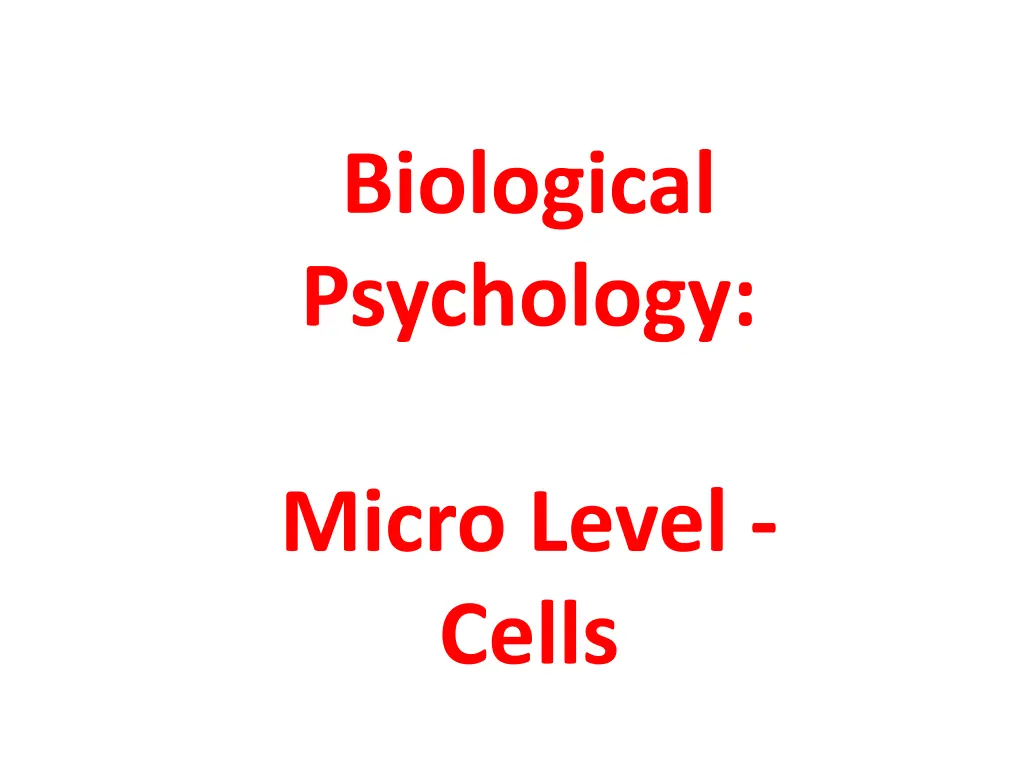
Understanding Historical Perspectives on the Brain and Cells in Biological Psychology
Explore the historical views on the brain from ancient Egyptians to the Greeks, Descartes, and Phrenology. Learn about the significance of cells in the nervous system, including the Neuron Doctrine and Cell Theory proposed in 1838. Dive into the micro-level study of cells in Biological Psychology.
Download Presentation

Please find below an Image/Link to download the presentation.
The content on the website is provided AS IS for your information and personal use only. It may not be sold, licensed, or shared on other websites without obtaining consent from the author. If you encounter any issues during the download, it is possible that the publisher has removed the file from their server.
You are allowed to download the files provided on this website for personal or commercial use, subject to the condition that they are used lawfully. All files are the property of their respective owners.
The content on the website is provided AS IS for your information and personal use only. It may not be sold, licensed, or shared on other websites without obtaining consent from the author.
E N D
Presentation Transcript
Biological Psychology: Micro Level - Cells
Historical Views on The Brain The earliest known symbol for brain appeared in Egyptian hieroglyphic, ~1,700 BCE (Before the Common Era). http://en.wikipedia.org/wiki/History_of_neuroscience#Early_views http://en.wikipedia.org/wiki/File:Hieroglyphic-brain.jpg Public Domain in the United States
Historical Views on The Brain Ancient Greeks Alcmaeon of Croton (5th 6th century BCE) A student of Pythagoras (A2 + B2 = C2) Considered the brain as the basis for mind Hippocrates (4th century BCE) Considered the brain to be the seat of intelligence Aristotle (384 322 BCE) Believed that the heart was the seat of intelligence The brain cooled the blood Humans are more rationale than non-human animals b/c larger brains allow greater cooling of emotions http://en.wikipedia.org/wiki/History_of_neuroscience
Historical Views on The Brain Rene Descartes (France, 1596-1650) Believed pineal gland to be the seat of the soul http://en.wikipedia.org/wiki/Ren%C3%A9_Descartes http://en.wikipedia.org/wiki/File:Illu_pituitary_pineal_glands.jpg http://en.wikipedia.org/wiki/File:Frans_Hals_-_Portret_van_Ren%C3%A9_Descartes.jpg
Historical Views on The Brain Phrenology Franz Joseph Gall (Germany 1796) Different skull shapes, sizes determine thoughts, feelings, behavior. Considered non-scientific today, although there is evidence for considerable localization of brain functions. (Skull size is too crude a measure, though.) http://en.wikipedia.org/wiki/File:PhrenologyPix.jpg Public Domain in the United States
http://www.thefreedictionary.com/cell+theory Cells in the Nervous System Cell Theory Proposed in 1838 by Matthias Schleiden and by Theodor Schwann. 1. All living organisms are composed of one or more cells. 2. The cell is the basic unit of structure and organization in organisms. 3. Cells arise from other cells. https://en.wikipedia.org/wiki/Cell_theory
http://www.thefreedictionary.com/cell+theory Cells in the Nervous System Neuron Doctrine The nervous system is made up of discrete individual cells, a discovery due to decisive neuro-anatomical work of Santiago Ramon y Cajal http://encyclopedia.thefreedictionary.com/neuron+doctrine
http://en.wikipedia.org/wiki/File:PurkinjeCell.jpg Cells in the Nervous System Drawing of Purkinje cells (A) and granule cells (B) from pigeon cerebellum by Santiago Ram n y Cajal, 1899; Instituto Cajal, Madrid, Spain.
http://commons.wikimedia.org/wiki/File:Pyramidal_hippocampal_neuron_40x.jpghttp://commons.wikimedia.org/wiki/File:Pyramidal_hippocampal_neuron_40x.jpg Cells in the Nervous System Golgi stained pyramidal neuron in the hippocampus of an epileptic patient. 40 times magnification.
Cells in the Nervous System Neuron An electrically excitable cell in the nervous system that transmits information through electrical and chemical signals. https://en.wikipedia.org/wiki/Neuron Cells All neurons are cells, but not all cells are neurons. Venn Diagram Neurons
Cells in the Nervous System Three Major Components of a Neuron Dendrite Nucleus Axon Neuron 2 Neuron 1 http://commons.wikimedia.org/wiki/File:Neuron.svg
Cells in the Nervous System Myelin fatty, white-ish sheath around axons Speeds neuronal communication Production begins in 14th week prenatally Frontal cortex myelination complete at ~age 25! Glial Cells non-neural cells that protect and serve neurons. Oligodendrocytes supply myelin in the central nervous system Schwann Cells supply myelin in peripheral nervous system
http://en.wikipedia.org/wiki/File:Neuron_with_oligodendrocyte_and_myelin_sheath.svghttp://en.wikipedia.org/wiki/File:Neuron_with_oligodendrocyte_and_myelin_sheath.svg Cells in the Nervous System
http://commons.wikimedia.org/wiki/File:Complete_neuron_cell_diagram_en.svghttp://commons.wikimedia.org/wiki/File:Complete_neuron_cell_diagram_en.svg
Cells in the Nervous System White Matter - a region of the central nervous system containing myelinated nerve fibers. Informally, white matter reflects connection speed Grey Matter - a region of the central nervous system containing cell bodies, dendrites, and non-myelinated axons. Informally, grey matter reflects computer power
http://commons.wikimedia.org/wiki/File:1202_White_and_Gray_Matter.jpghttp://commons.wikimedia.org/wiki/File:1202_White_and_Gray_Matter.jpg Cells in the Nervous System
